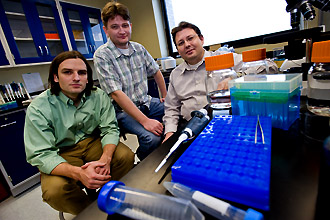Scientists Explore Blood Vessel Growth
Three new faculty members in the Tulane Department of Biomedical Engineering are leading the way in understanding how circulating cells are involved in the function and growth of microvascular networks. Each is studying blood vessels from a different angle, resulting in an interdisciplinary approach to the research.

Biomedical engineering researchers (from left) Walter “Lee” Murfee, Sergey Shevkoplyas and Damir Khismatullin are studying blood vessel growth from different angles. (Photo by Paula Burch-Celentano)
“Blood vessel growth is a common denominator in many diseases,” says Walter “Lee” Murfee III. “If you know what's there and how it gets there, then you can manipulate it to either inhibit or encourage vessel growth.”
In the case of cancer there's a need to inhibit growth to cut off the blood supply to tumors. With coronary artery disease, tissue injuries and diabetes, some therapies are aimed at getting new blood vessels to the impacted area.
In the Microvascular Dynamics Laboratory, Murfee uses vascular biology and physiology-oriented observations to ask questions about what cells are present within newly formed capillary sprouts, how they got there and what mechanical stresses are present within these tiny vessels.
Sergey Shevkoplyas approaches these problems using microfabrication and “lab-on-a-chip” technology to design and build artificial microvascular networks in the Biomedical Microdevices Laboratory.
“I can tease out all sorts of fundamental mechanisms by creating different variations of microvascular configurations in a microfluidic chip,” Shevkoplyas says.
In the Cellular Biomechanics and Biotransport Laboratory, Damir Khismatullin uses combined in vitro experimentation and computational models to simulate blood flow and behavior of circulating cells in microvascular networks to answer remaining unknowns and link together the different approaches.
“Significant progress in biomedical science can be achieved only through collaboration of researchers with different kinds of expertise, through the integration of experiments and modeling," Khismatullin says.
Donald Gaver, professor and chair of biomedical engineering, says, “We try to look at these problems from multiple viewpoints that are highly quantitative but also biologically accurate. There are not very many departments that have this kind of integrated strength."
Belinda Lacoste is a student studying journalism in the School of Continuing Studies and a staff member who writes for the School of Science and Engineering.
